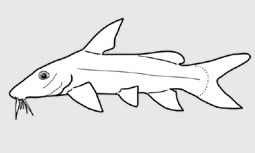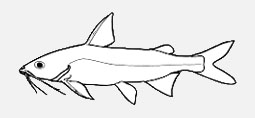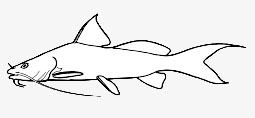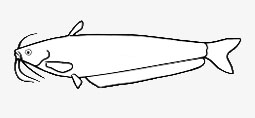Distribution: southeastern Asia. Dorsal fin with a short base and with 1 leading spine; usually five soft rays; usually with adipose fin. One strong pectoral spine, usually serrated. Relatively narrow gill openings. Longitudinal row of tubercles usually along body. Four pairs of barbels.
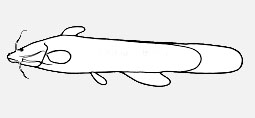
Amblycipitidae - (Torrent catfishes)
Distribution: southern Asia, Pakistan to southern Japan and Malaysia. Dorsal fin covered by thick skin. Adipose fin present, confluent with caudal fin in some species. Anal fin with only 9-18 rays. Barbels 4 pairs. Lateral line incomplete. Occurs in swift streams.
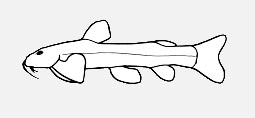
Amphiliidae - (Loach catfishes)
Distribution: Africa. Barbels 3 pairs. Short dorsal and anal fin bases. No spine in dorsal fin; dorsal spine feeble in Trachyglanis. Most species lacking pectoral spine. Occasionally a short spine in adipose fin. No pterygoid and posttemporal. Usually restricted to high altitude streams. Attains 18 cm maximum length; most species below 12 cm.
Glaw & Vences, 1994: 380. Type genus: Ancharius Steindachner, 1880. Not in FoW2006 (Ref. 58010). Revision, with key to species: Ng & Sparks (2005). No named fossil taxa. Suggested new common name for this family in a coming ref. following Ref. 58418.
Chiefly marine; occasionally freshwater. Distribution: tropical and subtropical waters. Forked caudal fin. Adipose fin present. Barbels usually 3 pairs, rarely 2 pairs. Nasal barbels absent. Bony plates present on head and near dorsal fin. A leading spine in both pectoral and dorsal fins. Many species enter freshwater and some are restricted to freshwater. Normally the male carries the relatively large eggs in its mouth until hatching.
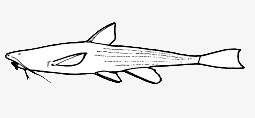
Aspredinidae - (Banjo catfishes)
Banjo catfishes are found in freshwater; occasionally brackish waters of tropical South America. Anterior part of body depressed. Body naked except for large tubercles. Adipose fin absent. Body depressed anteriorly; opercular aperture reduced to a slit; dorsal spine-locking mechanism absent in most species. About 42 cm maximum length attained in Aspredo aspredo; most below 15 cm. Members of Aspredininae live in coastal brackish waters.
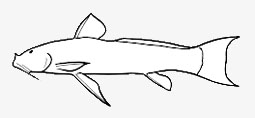
Astroblepidae - (Naked sucker-mouth catfishes)
Naked sucker-mouth catfishes are distributed in South America (Andean region) and Panama. Naked body. Mouth disc present; maxillary and nasal barbals present. With or without adipose fin. Dorsal spine without a locking mechanism; 6-7 dorsal soft rays. Intestine relatively short. Total vertebrae 34 (17 + 17). Some species live in torrental mountain streams and climb the faces of waterfalls. Maximum length about 30 cm.

Auchenipteridae - (Driftwood catfishes)
Driftwood catfishes are known to occur in rivers from Panama to Argentina. Naked body. Three pairs of barbels in all but one species, the maxillary pair being the longest. Pectoral and dorsal fins with a strong spine. With or without adipose fin. Pseudauchenipterus nodosus enters brackish waters. Includes Ageneiosidae (Ref. 37098), bottlenose or barbelless catfishes, 2 genera and 12 species, since Ferraris (1988; unpublished PhD Thesis).

Austroglanididae - (Austroglanids)
Southern Africa. Three pairs of barbels (nasal pair absent); strong dorsal and pectoral spines; adipose fin small. The genus Austroglanis was formely placed in Bagridae.
Distribution: Africa and Asia (to Japan and Borneo). A spine before dorsal fin. Dorsal soft rays usually 6 or 7 (rarely 8-20). Adipose fin with high interspecific variability in size. Serrated pectoral spine. Scaleless. Barbels usually four pairs; well-developed. Some valued as food fish; others as aquarium fish. Maximum length of about 2 m attained in Chrysichthys grandis of Lake Tanganyika (Ref. 7463). Family Claroteidae (Berra 2001) was carved out of the traditional Bagridae to reflect a monophyletic group of African catfishes. Two subfamilies are recognized, Claroteinae and Auchenoglanidinae, which together contain more than 90 species in 13 genera. Distribution includes the Nile River basin and most of west and central Africa south to the Tropic of Capricorn, including the east African lakes. Includes Auchenoglanis, Chrysichthys, Leptoglanis, and Parauchenoglanis. Another family taken from Bagridae is Austroglanididae to accommodate the southern African genus Austroglanis and its three species (Ref. 36739).
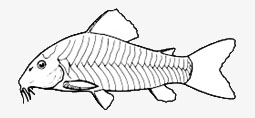
Callichthyidae - (Callichthyid armored catfishes)
Species of the family occurs in South America and Panama. Body with two rows of overlapping bony plates on each side. Swim bladder contained in bony case. Mouth small and ventral; one or two pairs of well-developed barbels present; dorsal and pectoral fins with strong spine; adipose fin with spine at anterior border. Air in vascular hindgut enables some species to travel short distances on land. All species are obligatory air-breathers. Callichthyids breathe air under all water conditions. In this family, however, swallowed air plays a more important role in the maintenance of the hydrostatic balance than in respiration itself (Ref. 37395). There are two basic reproductive strategies among the callichthyids. Members of the callichthyines exhibit the interesting behavior of building a floating nest composed of foam and vegetal debris for spawning. Members of the corydoradines, on the other hand, are substrate brooders and attach adhesive eggs to the substrate after a very elaborated spawning behavior (Ref. 37395).
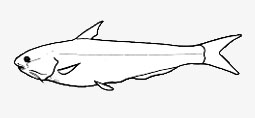
Cetopsidae - (Whale catfishes)
Whalelike catfishes occur in South America. Body naked. Barbels 3 pairs; nasal barbels absent. Adipose fin absent. Swim bladder extemely small, contained in a bony capsule. Includes now the Helogeneidae (Marbled catfishes).
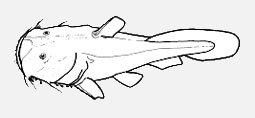
Chacidae - (Squarehead or angler catfish)
Distribution: India to Borneo (the 2 species occupying disjunct ranges). Head broad and depressed. Hind part of body compressed. Mouth large and terminal. Eyes reduced. One short leading spine in dorsal fin: soft rays 4. Anal fin soft rays 8-10. Pectoral fin having 1 serrated spine; soft rays 4 or 5. Large pelvic fins; fin rays 6. Adipose fin continuous with caudal fin. Branchiostegal rays 6-8. Total vertebrae 31-35; abdominals 14-16. About 24 cm maximum length. Maxillary barbels sometimes used to lure prey.
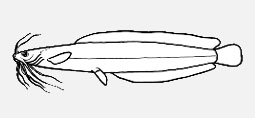
Clariidae - (Airbreathing catfishes)
Distribution: Africa, Syria and southern and western Asia (Philippines to Java). Dorsal fin extending over much of body length. Dorsal fin rays usually over 30 without a leading spine. Dorsal fin discontinuous or united to caudal fin. Rounded caudal fin. Wide gill openings. Barbels 4 pairs. Airbreathing is accomplished with a labyrinthic organ arising from the gill arches ('labyrinth catfishes'). Some species are capable of travelling over short distances on land ('walking catfishes'). Some are burrowers with small eyes and the pectoral and pelvic fins small or lacking.

Claroteidae - (Claroteid catfishes)
Distribution: African Siluriformes family. Short description: Body moderately elongated. 4 pairs of barbels. Dorsal and pectoral fins with strong spines. Adipose fin present. Taxonomy: Separated from Bagridae (Mo, 1991), and not including Auchenoglanididae (de Pinna, 1998).
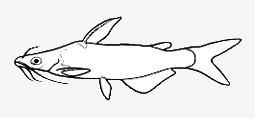
Cranoglanididae - (Armorhead catfishes)
Distribution: Asia. Short dorsal fin. Dorsal spine 1; branched rays 6 (rarely 5). Anal fin rays 35-41. Pectoral spine 1. Deeply forked caudal fin. Scaleless. Top of head with rough bony plates. Barbels 4 pairs. Resembles Pseudobagrus.

Diplomystidae - (Velvet catfishes)
These catfishes occur in southern South America, Chile and Argentina. Maxilla well developed. Teeth on maxilla. Lagenar otolith equal in size to or larger than the utricular otolith. Barbels present on maxilla. Dorsal fin with spine and 6-7 soft rays; anal fin with 9-12 principal rays; adipose fin present; pectoral fins with spine; caudal fin with 18 principal rays. Maximum length 28 cm. Common name for this family encoded from Ref. 58010.
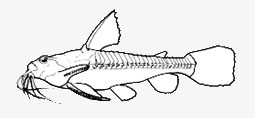
Doradidae - (Thorny catfishes)
Thorny catfishes are found in South America (primarily Brazil, Peru and the Guianas). A row of lateral bony plates along body. Dorsal fin with spine and 4-6 soft rays. Barbels 3 pairs; nasal barbels absent. Usually with adipose fin. Sometimes called 'talking catfishes' because of their sound production, made either by movements of the pectoral spine or by vibrating the swim bladder. Maximum length about 80 cm.
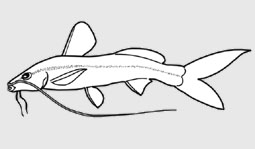
Heptapteridae - (Three-barbeled catfishes)
Distribution: South America. Suggested new common name for this family from Ref. 58418.
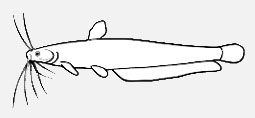
Heteropneustidae - (Airsac catfishes)
Distribution: Pakistan to Thailand. Elongate and compressed body. Head strongly depressed. Barbels 4 pairs. A long air sac that serves as a lung extends backwards from gill chamber. Short dorsal fin with no leading spine. No adipose fin or present as a low ridge. Pectoral spines with associated poison gland dangerous to humans.
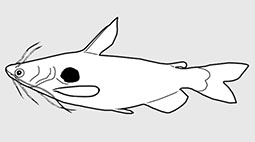
Horabagridae - (Imperial catfishes)
Valid family according to Sullivan et al., 2006. Sullivan, J. P., J. G. Lundberg, and M. Hardman. 2006. A phylogenetic analysis of the major groups of catfishes (Teleostei : Siluriformes) using rag1 and rag2 nuclear gene sequences. Molecular Phylogenetics and Evolution. 41:636-662. Species will be allocated for the next update.
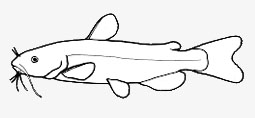
Ictaluridae - (North American freshwater catfishes)
Distribution: North America from southern Canada to Guatemala. Head with eight barbels: 2 nasal, 2 maxillary and 4 chin. Scaleless. A spine on anterior edge of dorsal (except in Pritella) and pectoral fins. Dorsal soft rays usually 6. No palatine teeth. About 1.6 m maximum length attained in Ictalurus furcatus and Pylodictis olivaris. Three unrelated eyeless species are known from deep wells.
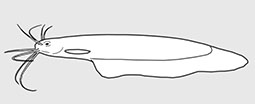
Kryptoglanidae - (Indian cave catfishes)
Distribution: Asia. Lacks the vomer, metapterygoid, all infraorbital bones except the antorbital, the mesocoracoid, and the pectoral-fin spine. No trace of dorsal fin or its supporting skeleton. Lack of fusion or even any suturing of the fifth vertebra with the Weberian complex. Anal-fin rays are supported by 71 petrygiophores. Anal fin with 72 rays, of which all but the first are serially associated with 71 petrygiophores. Caudal fin skeleton is composed of a single hypural plate articulating with five rays.
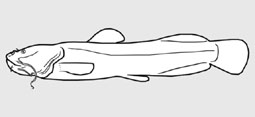
Lacantuniidae - (Chiapas catfishes)
North America, Mexico. Inhabits deep river channels and pools with rocks and strong eddy currents; sometimes taken in stream mouths.
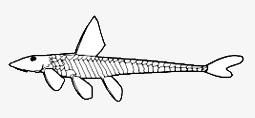
Loricariidae - (Armored catfishes)
Armored catfishes are found in Costa Rica, Panama and South America. Bony plates on body (rarely absent). Mouth inferior with or without conspicuous barbels. Papillae on ventral lip. Adipose fin absent or, when present, with a spine at anterior border. Intestine relatively long. Vertebrae 23-38. Species occur in swift-flowing streams from lowlands up to 3,000 m. Popular aquarium fish as 'Plecostomus'. 7 subfamilies Ref. 58010 + Ref.): - Loricariinae - Ancistrinae - Delturinae - Hypostominae - Hypotopomatinae - Lithogeneinae - Neoplecostominae
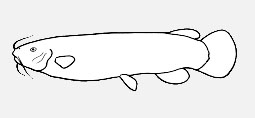
Malapteruridae - (Electric catfishes)
Distribution: tropical Africa and Nile. Dorsal fin absent. Adipose fin close to caudal fin. Generate strong electrical currents.
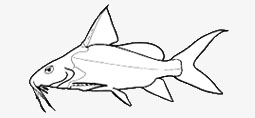
Mochokidae - (Squeakers or upside-down catfishes)
Distribution: Africa. Adipose fin usually very large; anal fin with fewer than 10 rays; dorsal and pectoral fin spines usually strong and with locking mechanism; three pairs of barbels, nasal barbels absent and mandibular barbels may have numerous branches; some with lips and part of barbels modified into an oral sucker (Atopochilus, Chiloglanis, and Euchilichthys); the two species of Mochokus of the Nile system have a rayed adipose fin. Maximum length 72 cm.
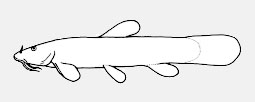
Nematogenyidae - (Mountain catfishes)
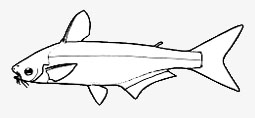
Pangasiidae - (Shark catfishes)
Distribution: southern Asia (Pakistan to Borneo). Barbels usually two pairs: 1 pair of chin barbels. No nasal barbels. Compressed body. With small adipose fin, separate from caudal fin. Dorsal fin close to head region; 1 or 2 spines, 5-7 soft rays. Anal fin 26-46 rays. Vertebrae 39-52. Maximum length about 3 m . Maximum weight 300 kg (Pangasius gigas). Only one species occurs in true marine waters Pangasius krempfi Fang & Chaux, 1949.

Phreatobiidae - (Cistern catfishes)

Pimelodidae - (Long-whiskered catfishes)
Since FoW3 (Nelson, 1994: Ref. 7463), Pimelodidae includes the monotypic Hypophthalmidae (Loweye catfishes), Hypophthalmus with 4 spp. (de Pinna, 1998: Ref. 33205), and excludes the Heptapteridae and Pseudopimelodidae, as well as Conorhynchos conirostris now incertae sedis (Lundberg & Littmann, 2003: Ref. 36506). The following information must be updated. Long-whiskered catfishes are known from Central and South America (north to southernmost Mexico). Naked body. Adipose fin present, sometimes small. Barbels 3 pairs. Spines of pectoral and dorsal fins may be present or absent. Maximum length about 3 m (Brachyplatystoma filamentosum). Some pelagic and probably filter feeders (Hypophthalmus spp.).
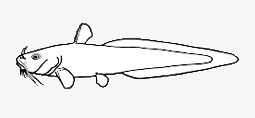
Plotosidae - (Eeltail catfishes)
Distribution: Indo-West Pacific (Japan to Australia and Fiji). Eel-like body. Pointed or bluntly-rounded tail. Barbels usually 4 pairs. Adipose fin absent. Caudodorsal fin rays may be far advanced along dorsal. Lower procurrent caudal rays confluent with long anal fin. Branchiostegal 7-14 rays. Some can cause painful injury. Most are freshwater species = ISSCAAP 13; few are marine = ISSCAAP 39. They are bottom feeders and use the barbels around their mouth to detect food.

Pseudopimelodidae - (Bumblebee catfishes, dwarf marbled catfishes)
Distribution: South America. Wide mouth, small eyes without free orbital margin and short barbels. Some genus with beautiful pattern of coloration with wide dark brown blotches in the trunk. Reaches up to 40 cm.
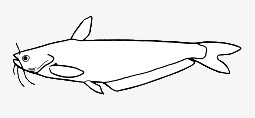
Schilbeidae - (Schilbid catfishes)
Distribution: Africa and southern Asia. Dorsal fin with short base and 1 spine, when present. Usually with adipose fin. Anal fin base very long, separate from caudal fin; with 24-90 rays. Barbels usually 4 pairs. Pelvic fin occasionally absent in species of some genera. Distinct pairing (Ref. 205). Oviparous, eggs are unguarded (Ref. 205).
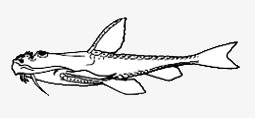
Scoloplacidae - (Spiny dwarf catfishes)
South America (Peru, Bolivia, and Brazil). Two bilateral series of odontode-bearing plates; one midventral series of plates; numerous curved odontodes on rostral plate as well as on many other parts of the body. Dorsal fin with stout smouth spine and 3-5 soft rays; anal fin with 5-6 soft rays. Maximum length about 2 cm. Formerly recognized as subfamily of Loricariidae.
Distribution: Europe and Asia. Dorsal fin rays usually less than 7, when present. No spine before dorsal fin. No adipose fin. Pelvic fins small or absent. Anal fin base very long with 41-110 rays. Nasal barbel absent, one or two pairs of barbels on lower jaw, and maxillary barbels usually elongate. Maximum length of 5 m reached in Silurus glanis, with 330 kg. This European species may enter brackish waters.

Sisoridae - (Sisorid catfishes)
Distribution: southern Asia, from Turkey and Syria to South China and Borneo, primarely in Oriental region. Four pairs of barbels (except Sisor). Adipose fin usually large; reduced to a small spine in Sisor. Some with the adipose fin united to caudal fin. Dorsal fin with or without spine; the base short. With or without an adhesive apparatus in the thoracic region. Reaches 2 m maximum length in one species. Mostly small forms inhabit mountain rapids.
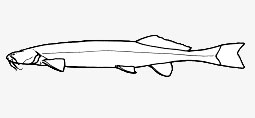
Trichomycteridae - (Pencil or parasitic catfishes)
Distribution: from Costa Rica to Patagonia, and on both sides of the Andes, from lowland streams of the Atlantic coast of Brazil to high elevation Andean streams and lakes at 4500 m above sea level (Ref. 119411). Naked and elongate body. Usually 2 pairs of barbels on maxilla, lacking on chin. Adipose fin absent. Opercle often with spines. Pelvic fins have been lost in at least 3 lineages - Eremophilus, Miuroglanis, and Glanapteryginae. A number of genera are parasitic, attacking gill tissue of larger fishes. Vandellia is known to enter the urethra of humans, causing serious harm. The family is prohibited from importation into parts of the USA (Ref. 4537).
Note: Families with unknown counts of dorsal or anal spines are also included


